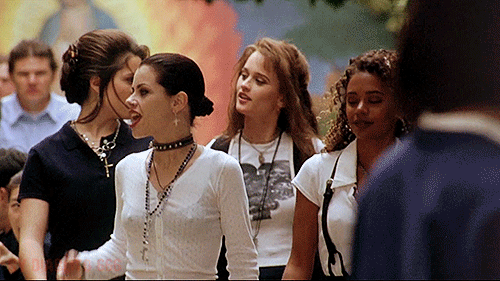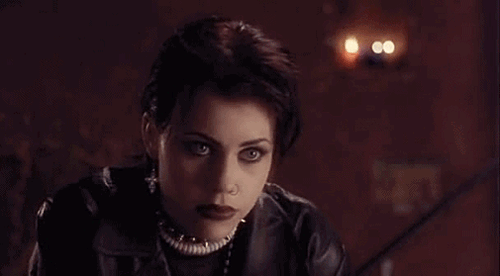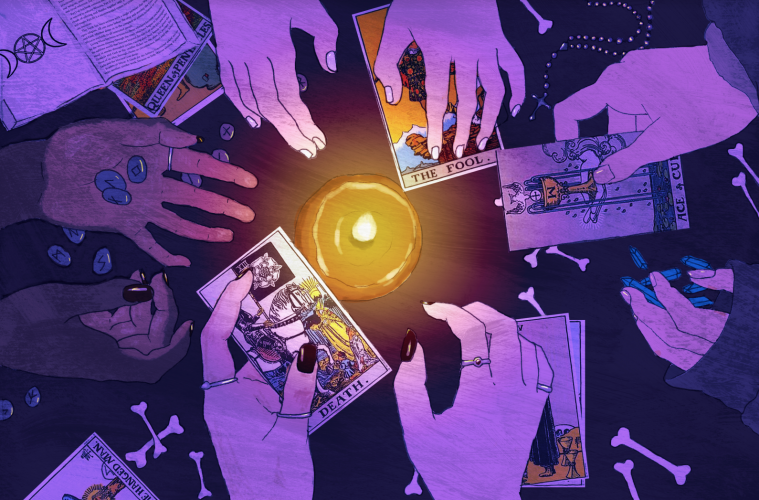“Now is the time, this is the hour. Ours is the magic, ours is the power.”
Surrounded by the steady hum of crickets and the trill of birdsong, four teenaged girls sit cross-legged on the dry summer grass, in the balmy shade of a gnarled tree. Their hands are joined, their eyes shut in deep contemplation as they repeatedly chant in unison, “Earth, air, fire, water.” They each dispense a bright crimson drop of blood from their fingertips into a silver chalice of red wine to be passed around, atop a blanket spread of pentagrams, smoking incense, quartz crystals, tarot cards, velvet pouches, framed photographs, and leather-bound books.
The scene is hazy with the mysticism of the occult, a sense of adolescent secrecy, a clandestine meeting of a coven. For this spectacle is of a witch’s private altar laid bare amongst the natural world, and it marks the turning point in which the protagonist, Sarah (Robin Tunney), is finally being initiated into a coven – a sisterhood consisting of Nancy (Fairuza Balk), Bonnie (Neve Campbell), and Rochelle (Rachel True). She is accepted into a new social circle, no longer a solitary witch invisible on the fringes of high-school society.
When Andrew Fleming’s The Craft arrived in 1996, it bewitched a generation of teenage girls, galvanising those who identified as misfits or outsiders to seek out the practice of witchcraft. The film contributed to a burgeoning presence of headstrong, steely witches in 90s pop culture – including Sabrina the Teenage Witch (1996-2003), Buffy the Vampire Slayer (1997-2003), Charmed (1998-2006), Practical Magic (1998), and Hocus Pocus (1993) – that all explored the possibilities and limitations of female empowerment and agency via the channel of witchcraft. In recycling grungy regalia such as smudged dark eyeliner, black studded chokers, layers of rosary beads, and crucifix earrings, The Craft simultaneously re-imagined Catholic schoolgirl uniforms for the trending gothic subculture – complete with tartan skirts and knee-high socks – and breathed life into the tired and wearisome image of the haggard witch.
The witches of The Craft were defiant with the confidence of girlish youth, unapologetic in their sexual liberty, and flippant in the face of authority. The four leading characters became poster girls for women who refused to be tamed by patriarchal norms; icons for teenagers bordering the liminal cusp of girlhood and womanhood, and inspirations for a re-ignited interest in the occult, paganism, and Wicca. However, for all the free-spirited independence the film depicted, and with the surface-level motifs of magical power and ability, it also engaged with themes of power, responsibility, and consequence in what some may view as a rather conservative approach considering the film’s unorthodox subject matter.

The Craft invites the audience on a journey with Sarah Bailey, a troubled and reclusive teen who relocates to L.A. with her father and stepmother. Fresh from the ashes of an attempted suicide, she is the newest arrival at a Catholic school fraught with stereotypical cliques – the obligatory outsider left to navigate the perils of high school alone. On the surface, nothing about Sarah’s external appearance suggests the fact that she dabbles in witchcraft or any practice of the sort, until Bonnie is the only one to witness her magical ability in the middle of class – rotating an upright pencil on her desk so it seems to bore into the wooden surface, using nothing but her mind. A startled Bonnie gasps in disbelief, and Sarah’s focus is instantly severed as they make eye contact, which sends the pencil rolling to the classroom floor. “She’s here!” Bonnie whispers to her fellow witches, Nancy and Rochelle, shortly afterwards in lab; she being the fourth witch, and the final addition to the clandestine sisterhood. Sarah’s arrival marks the fulfilment of a prophetic message in Bonnie’s almanac earlier on: “A new wholeness, and with it a new balance. Earth, air, water, fire,” which suggests the necessity of her presence in their lives. Sarah’s gifts are natural, innate, and benevolent – powers passed down from her late mother who died in childbirth – offering juxtaposition against the other girls’ more formulaic, methodological, and malicious approach to spell-work and magic.
“We don’t need a fourth,” Nancy asserts defensively as she tugs on a black noose in her locker, quick to establish her animosity towards the notion of Sarah even before their first encounter. As the most impulsive, dominant, and intimidating of the three girls, Nancy’s status as leader of the pack is disrupted by Sarah’s appearance. It is her deep insecurity over retaining her hegemony that oversees a battle between the two for leadership over the course of the film. There is a constant flux in the dynamics of power between the two powerful witches as their brittle relationship straddles kinship and hostility. Once Sarah has been accepted and assimilated into the coven, the film delves into the utopic vision of ‘typical’ teen friendship: of sun-soaked bus rides, jovial sleepovers, movie nights, coordinated outfits, and plenty of laughter. At the height of their alliance, the girls fall perfectly into step with each other, each identity and individual sense of style gradually melding together so that they resemble a punk-inspired girl band of shiny PVC, leather, miniskirts, and accessories. Strutting down the school hallway together, they seem unstoppable, vivacious, and positively dangerous.
It is indisputable that the collective power of the four teenage witches is thunderous in intensity, but it is their individual choices when using their powers that truly expose their cores and individual values. Each witch in the film wields her power uniquely. Each faces markedly different problems in life, and therefore has different intentions and decisions to make. During the initiation scene, as the girls take turns sipping their blood-infused wine from the chalice, they call on a higher power to gift them their desires, an almighty spirit Nancy reveals as “Manon.” Both Sarah and the audience learn that Manon is more ancient than modern-day deities and the notion of the Abrahamic God. Placed into perspective, “If God and the Devil were playing football, Manon would be the stadium that they played on. It would be the sun that shone down on them,” Nancy eulogizes in a rare moment of tenderness. “[Manon] is everything. It’s the trees, it’s the ground, it’s the rocks, it’s the moon. It’s everything,” she continues to muse, and surely enough, a mesmerising kaleidoscope of butterflies flutter around the girls as they laugh in awe and disbelief. Manon has listened, and bestows otherworldly powers on the witches – but in the universe, there exists the “basic spiritual truth,” reflected in the wise words of the occultist shop owner, Lirio (Assumpta Serna): “Whatever you send out, you get back times three.”
In the case of wallflower Bonnie – whose burn scars from childhood have marred her self-esteem and confidence until this point – her wish is for “the power to be beautiful outside as well as in.” Later on, at one of her routine medical appointments where painful lasers had once seared into her skin as a form of innovative therapy, Bonnie’s scars merely shed off; akin to the way a snake sheds and renews its skin. Her physical change is a catalyst for her psychological transformation, as she struts into the classroom the next day wearing more revealing clothing and sporting new hair – no longer hidden behind hardback books clutched to her chest, highly drawn turtlenecks, and long, sweeping bangs. Bonnie relishes the sexual attention of her male classmates, and she savours the shock of her fellow witches. However, her newly asserted confidence and narcissistic traits arrive tinged with an air of cruelty and malice.
As a young Black woman, Rochelle is tormented by the racist vitriol of a fellow student (Christine Taylor) – and when it is her turn to drink from the chalice, she vocalizes her wish as “the ability to not hate those who hate me, especially racist pieces of bleached-blonde shit like Laura Lizzie.” Following bouts of bullying – from receiving abhorrent taunts about her natural hair, to Laura directly proclaiming, “I don’t like negroids” – Rochelle’s vengeance manifests as Laura gradually loses her blonde locks over the coming weeks. In the school’s showers and changing rooms, where most of Rochelle and Laura’s encounters take place, an inconsolable Laura is often spotted crying and clutching at what is left of her alopecia-stricken scalp. The transaction of power between the two girls reverses; the currency being hair, and its cultural association with beauty and femininity. With Rochelle’s simple desire to “not hate” her racist adversary, the universe grants her the power of a superior position of feeling pity for her bully instead, supplanting the chances of reaching an amicable truce.

Nancy remains the most troubled individual in The Craft, and her characterisation rests upon the “white trash” stereotype of an unstable, abusive, and alcohol-fuelled family. Living in debt and poverty (with rain often leaking from holes in the roof), a misogynistic and violent stepfather, and a tawdry mother, Nancy’s issues derive from the fact that she is financially disadvantaged and resents her home environment. As Nancy feels a lack of control of her situation, she invites “all the power of Manon” into her body when it is her turn to drink from the chalice. It is an extremely ambitious feat, contributing to her hubris and declining instability, as well as placing a strain on her relationship with the other four witches.
On an evening where Nancy is increasingly embittered with her apparent lack of magic abilities, her drunken stepfather attempts to look under her nightgown, provoking a defensive response from her mother. As he attacks her mother, Nancy unleashes her pent-up rage, causing a kitchen fire and her stepfather’s sudden heart attack. As he hyperventilates in pain, she glares at him defiantly, embracing her newfound power in the role of his death. Nancy and her mother find themselves the recipients of $175,000 through her deceased stepfather’s pension plan – suddenly, there is the promise of a fresh new start in a brand new, high-rise apartment with sweeping, panoramic views of the city. While Nancy’s mother fawns over her latest jukebox purchase filled with Connie Francis records, Nancy is able to host the girls at her pad for the first time. Her new financial power releases her from the shackles of poverty, imbuing her with materialistic freedom, but she remains dissatisfied in her inability to master the craft – unlike Sarah, of whom she grows more envious by the day.
As newcomer Sarah is instantly attracted to a fellow student named Chris (Skeet Ulrich), but is publicly mocked by him and his sexist friends after she declines his sexual advances on their date, her revenge in the form of a love spell backfires spectacularly. At first, much to the girls’ amusement, Chris becomes enamoured with Sarah, pining after her and obeying her every command around school. His infatuation mutates into intense obsession and full-blown stalking, and he appears outside her window as she sleeps, which escalates to a traumatic attempted rape on a hillside. In retaliation, Nancy seeks to harm Chris, but kills him in the process, creating an irreparable divide between Sarah and herself. It is suggested that Nancy’s killing of Chris is not wholly accidental, and it is this realisation that propels the conflict in the final act of the film.
While The Craft explores the usage of power in individualistic terms, following the trajectories of the witches’ experiences with their new abilities gifted by Manon, it still retains a conservative approach in the way female power has been depicted. Bonnie and Rochelle are punished for their vanity and spite, respectively, but Nancy pays the biggest price for daring to want too much, to go too far. The tender and kind-hearted presence of Lirio acts as Sarah’s moral compass in moments of crisis, as she tells her, “True magic is neither black nor white…the only good or bad is in the heart of the witch.”
Throughout the film, the message is reinforced that of the four, Sarah is the only witch with natural gifts – the only witch naturally capable of performing a “glamour” spell, for example – and consequentially, remains the most pure with true power. Sarah’s reluctance to fall into the trappings of temptation and Nancy’s influence means that Manon and the universe leave her relatively unscathed and unpunished when the cosmic scales are re-balanced to equilibrium. Once Sarah and Nancy engage in their final fight – the former attempting to neutralise the situation, the latter resolved to kill – Sarah is able to use her powers gifted by Manon to usurp Nancy’s abused privileges. Defeated and mentally compromised, Nancy’s fate is bleak as she is committed to an asylum, while Bonnie and Rochelle are completely stripped of any magical abilities. The lesson learned is that power can be demanded and used, but within harmless parameters, and for a ‘good’ and greater purpose. The forces of nature are only as forgiving as the sacred rule of three; there will always be consequences when power is wielded for whatever purpose, in the same vein as karmic retribution. As the coven disbands, Sarah finds herself a solitary witch yet again, but – it is safe to assume – a little wiser than before.

